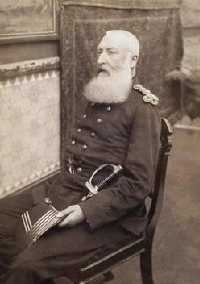 SKC Films Library SKC Films Library |
| SKC Films Library >> General and Old World History >> Low Countries >> Belgium >> 1794-1909 |
 Leopold
II Leopold
IIKing of Belgium, 1865-1909 Léopold Louis Philippe Marie Victor was born at Laeken Palace, near Brussels, on April 9, 1835, the first of three children born to King Leopold and Queen Louise. In 1846 he was created Duke of Brabant and appointed a Sub-Lieutenant in the army, in which he served until his accession, by which time he had reached the rank of Lieutenant-General. On attaining his majority in 1853 he was made a member of the Senate, in whose proceedings he took a lively interest, especially in matters concerning the development of Belgium and its trade. On August 22, 1853, Leopold married Marie Henriette, daughter of the Archduke Joseph of Austria, Palatine of Hungary, by his wife Marie Dorothea, Duchess of Württemberg. The arranged marriage resulted in four children -- Louise Marie Amélie (born in 1858), who in 1875 married Philip of Saxe-Coburg and Gotha, and was divorced in 1906; Leopold (1859), who died in 1869 after falling into a pond and catching pneumonia; Stéphanie (1864), who married Rudolph, crown prince of Austria, in 1881, and, after his death in 1889 married, against her father's wishes, Elemer, Count Lonyay, in 1900; and Clémentine (1872). Between the years 1854 and 1865, Prince Leopold travelled abroad, visiting India and China, as well as Egypt and all of the countries on the Mediterranean coast of Africa. He became King of Belgium upon the death of his father on December 10, 1865, and took the constitutional oath on December 17. His Reign The most significant events of King Leopold II's reign centered on his desire to make Belgium an important colonial power. On December 12, 1876, he convened an international conference in Brussels of scientists, geographers and explorers, focusing on the discovery of the center of Africa. This resulted in the setting up, in 1877, of the Association Internationale Africaine, an "association for the civilisation and exploration of Central Africa." In 1878, he enlisted the services of Henry Morton Stanley, who had explored much of the Congo River in the early-1870's, to help him establish the Comité d'Études du Haut Congo (Study Committee on the Upper Congo), which became the International Association of the Congo the following year. From 1879 to 1884, Stanley signed contracts with hundreds of tribal chieftains, giving King Leopold unchecked power over a territory of more than 800,000 square miles. Leopold named his colony the Congo Free State. In 1885, the Berlin Conference recognized the État Indépendant du Congo (Independent State of the Congo), with Leopold II as its Sovereign. That same year, the Belgian Parliament authorized the King to be the Head of State of Congo. The region would go through several names over the next century -- the Belgian Congo, the Republic of the Congo, Zaire, and the Democratic Republic of the Congo. Almost from its very establishment, the Belgian Congo became the subject of much international indignation due to reports of King Leopold's oppressive rule over its inhabitants. Although it was not uncommon for European nations to exploit their colonies and their populations for their resources (including slaves), many visitors to the Belgian Congo recited tales of horrific acts of violence committed against its population. In addition, while King Leopold II used some of the mineral resources obtained from the territory to fund public works projects in Belgium, the majority of profits appeared to go into his pockets. One individual who toured the area was author Joseph Conrad, whose 1899 novel Heart of Darkness was largely based on things he saw and/or heard about. Shortly after 1900, British newspapers began publishing stories about the Belgian regime based on the work of an Englishman named E.D. Morel. Although these accounts were not the first to be widely published, they were the most sustained and effective, and in their wake an international protest movement formed. The King responded to the protest by hiring well-connected lobbyists to get him good press and granting lucrative Congo business licenses to the Rockefellers, the Guggenheims, and others. In 1904 he set up an International Commission of Inquiry, which recognized the merits of the royal action in Congo, while pointing out abuses and shortcomings. None of the King's actions quelled the international outrage, however, and in 1908 he was forced to sell all of his personal assets in the colony and transfer its control to the Belgian Parliament. King Leopold II died in his bed at Laeken Palace on December 17, 1909, and was buried at Notre Dame Church, Laeken. He was succeeded by his nephew, who reigned as King Albert I.
SOURCES SEE ALSO |
| SKC Films Library >> General and Old
World History >> Low Countries >> Belgium >> 1794-1909 This page was last updated on May 29, 2017. |